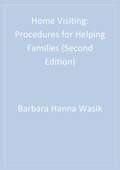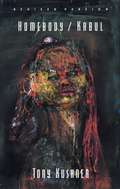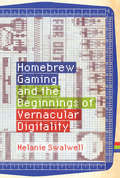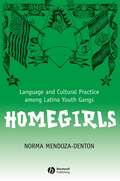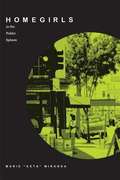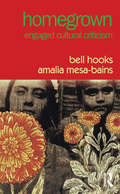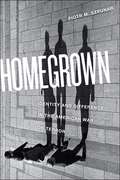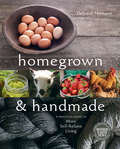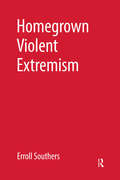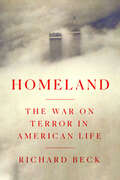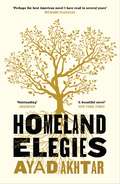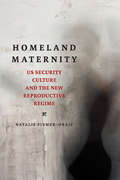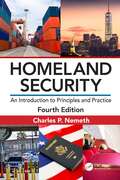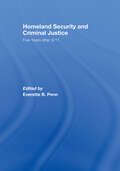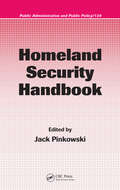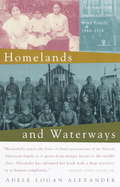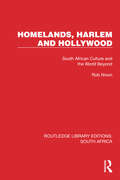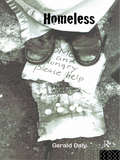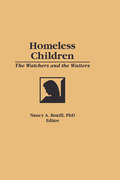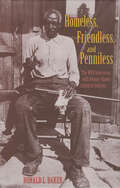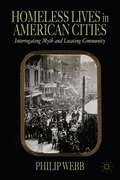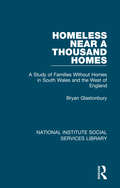- Table View
- List View
Home Visiting: Procedures for Helping Families (Second Edition)
by Dr Donna Bryant Barbara Hanna WasikThis Second Edition is a good source for those training to be home visitors, in-service home visitors, supervisors and directors of home visiting programs serving a wide range of families. Recent evaluations of home visiting are summarized and practical suggestions for evaluating local programs are also included. This is an easy to read and essential resource for both beginning and experienced home visitors, trainers, supervisors of home visitors, and directors of home visiting programs.
Homebody/Kabul
by Tony Kushner"Tony Kushner's Homebody/Kabul is the most remarkable play in a decade . . . without a doubt the most important of our time."--John Heilpern, New York Observer"This compelling evening testifies that Mr. Kushner can still deliver his sterling brand of goods: a fusion of politics, poetry and boundless empathy transformed through language into passionate, juicy theater . . . a reminder of how essential and heartening Mr. Kushner's voice remains."--Ben Brantley, New York Times"Homebody/Kabul is a rich and intelligent piece."--Peter Brook"Searing . . . Kushner's use of language and ideas continues to make us think about the deeper questions . . . he makes the political personal . . . a masterful conglomerate of words, ideas and history."--Mary Houlihan, Chicago Sun TimesIn Homebody/Kabul, Pulitzer Prize-winning playwright Tony Kushner, author of Angels in America, has turned his penetrating gaze to the arena of global politics to create this suspenseful portrait of a dangerous collision between cultures. Written before 9-11, this play premiered in New York in December 2001 and has had subsequent highly successful productions in London, Providence, Seattle, Chicago and Los Angeles. This version incorporates all the playwright's changes over the past two years and is now the definitive version of the text.Tony Kushner's plays include A Bright Room Called Day and Slavs!; as well as adaptations of Corneille's The Illusion, Ansky's The Dybbuk, Brecht's The Good Person of Szecguan and Goethe's Stella. Current projects include: Henry Box Brown or The Mirror of Slavery; and two musical plays: St. Cecilia or The Power of Music and Caroline or Change. He recently collaborated with Maurice Sendak on an American version of the children's opera, Brundibar. He grew up in Lake Charles, Louisiana, and he lives in New York.
Homebrew Gaming and the Beginnings of Vernacular Digitality (Game Histories)
by Melanie SwalwellThe overlooked history of an early appropriation of digital technology: the creation of games though coding and hardware hacking by microcomputer users.From the late 1970s through the mid-1980s, low-end microcomputers offered many users their first taste of computing. A major use of these inexpensive 8-bit machines--including the TRS System 80s and the Sinclair, Atari, Microbee, and Commodore ranges--was the development of homebrew games. Users with often self-taught programming skills devised the graphics, sound, and coding for their self-created games. In this book, Melanie Swalwell offers a history of this era of homebrew game development, arguing that it constitutes a significant instance of the early appropriation of digital computing technology. Drawing on interviews and extensive archival research on homebrew creators in 1980s Australia and New Zealand, Swalwell explores the creation of games on microcomputers as a particular mode of everyday engagement with new technology. She discusses the public discourses surrounding microcomputers and programming by home coders; user practices; the development of game creators' ideas, with the game Donut Dilemma as a case study; the widely practiced art of hardware hacking; and the influence of 8-bit aesthetics and gameplay on the contemporary game industry. With Homebrew Gaming and the Beginnings of Vernacular Digitality, Swalwell reclaims a lost chapter in video game history, connecting it to the rich cultural and media theory around everyday life and to critical perspectives on user-generated content.
Homegirls
by Norma Mendoza-DentonIn this ground-breaking new book on the Norteña and Sureña (North/South) youth gang dynamic, cultural anthropologist and linguist Norma Mendoza-Denton looks at the daily lives of young Latinas and their innovative use of speech, bodily practices, and symbolic exchanges that signal their gang affiliations and ideologies. Her engrossing ethnographic and sociolinguistic study reveals the connection of language behavior and other symbolic practices among Latina gang girls in California, and their connections to larger social processes of nationalism, racial/ethnic consciousness, and gender identity.An engrossing account of the Norte and Sur girl gangs - the largest Latino gangs in California Traces how elements of speech, bodily practices, and symbolic exchanges are used to signal social affiliation and come together to form youth gang styles Explores the relationship between language and the body: one of the most striking aspects of the tattoos, make-up, and clothing of the gang members Unlike other studies - which focus on violence, fighting and drugs - Mendoza-Denton delves into the commonly-overlooked cultural and linguistic aspects of youth gangs
Homegirls in the Public Sphere
by Marie Keta" MirandaGirls in gangs are usually treated as objects of public criticism and rejection. Seldom are they viewed as objects worthy of understanding and even more rarely are they allowed to be active subjects who craft their own public persona--which is what makes this work unique. In this book, Marie "Keta" Miranda presents the results of an ethnographic collaboration with Chicana gang members, in which they contest popular and academic representations of Chicana/o youth and also construct their own narratives of self identity through a documentary film, It's a Homie Thang!<P><P>In telling the story of her research in the Fruitvale community of Oakland, California, Miranda honestly reveals how even a sympathetic ethnographer from the same ethnic group can objectify the subjects of her study. She recounts how her project evolved into a study of representation and its effects in the public sphere as the young women spoke out about how public images of their lives rarely come close to the reality. As Miranda describes how she listened to the gang members and collaborated in the production of their documentary, she sheds new light on the politics of representation and ethnography, on how inner city adolescent Chicanas present themselves to various publics, and on how Chicana gangs actually function.
Homegrown: Engaged Cultural Criticism
by bell hooks Amalia Mesa-BainsIn Homegrown, cultural critics bell hooks and Amalia Mesa-Bains reflect on the innate solidarity between Black and Latino culture. Riffing on everything from home and family to multiculturalism and the mass media, hooks and Mesa-Bains invite readers to re-examine and confront the polarizing mainstream discourse about Black-Latino relationships that is too often negative in its emphasis on political splits between people of color. A work of activism through dialogue, Homegrown is a declaration of solidarity that rings true even ten years after its first publication. This new edition includes a new afterword, in which Mesa-Bains reflects on the changes, conflicts, and criticisms of the last decade.
Homegrown: Identity and Difference in the American War on Terror (Critical Cultural Communication #24)
by Piotr M. SzpunarAn insightful study of how identity is mobilized in and for war in the face of homegrown terrorism. “You are either with us, or against us” is the refrain that captures the spirit of the global war on terror. Images of the “them” implied in this war cry—distinct foreign “others”—inundate Americans on hit television shows, Hollywood blockbusters, and nightly news. However, in this book, Piotr Szpunar tells the story of a fuzzier image: the homegrown terrorist, a foe that blends into the crowd, who Americans are told looks, talks, and acts “like us.” Homegrown delves into the dynamics of domestic counterterrorism, revealing the complications that arise when the terrorist threat involves Americans, both residents and citizens, who have taken up arms against their own country. Szpunar examines the ways in which identities are blurred in the war on terror, amid debates concerning who is “the real terrorist.” He considers cases ranging from the white supremacist Sikh Temple shooter,,to the Newburgh Four, ex-convicts caught up in an FBI informant-led plot to bomb synagogues, to ecoterrorists, to the Tsarnaev brothers responsible for the Boston Marathon bombing. Drawing on popular media coverage, court documents, as well as “terrorist”-produced media, Szpunar poses new questions about the strategic deployment of identity in times of conflict. The book argues that homegrown terrorism challenges our long held understandings of how identity and difference play out in war—beyond “us versus them”—and, more importantly, that the way in which it is conceptualized and combatted has real consequences for social, cultural, and political notions of citizenship and belonging. The first critical examination of homegrown terrorism, this book will make you question how we make sense of the actions of ourselves and others in global war, and the figures that fall in between.
Homegrown and Handmade
by Deborah NiemannOur food system is dominated by industrial agriculture and has become economically and environmentally unsustainable. The incidence of diet-related diseases, including obesity, diabetes, hypertension, cancer, and heart disease, has skyrocketed to unprecedented levels. Whether you have forty acres and a mule or a condo with a balcony, you can do more than you think to safeguard your health, your money, and the planet.Homegrown and Handmade shows how making things from scratch and growing at least some of your own food can help you eliminate artificial ingredients from your diet, reduce your carbon footprint, and create a more authentic life. Whether your goal is increasing your self-reliance or becoming a full-fledged homesteader, it's packed with answers and solutions to help you:*Take control of your food supply from seed to plate*Raise small and medium livestock for fun, food, and fiber*Rediscover traditional skills to meet more of your family's needs than you ever thought possibleThis comprehensive guide to food and fiber from scratch proves that attitude and knowledge is more important than acreage. Written from the perspective of a successful self-taught modern homesteader, this well illustrated, practical, and accessible manual will appeal to anyone who dreams of a simpler life.Deborah Niemann is a homesteader, writer, and self-sufficiency expert who presents extensively on topics including soapmaking, bread baking, cheesemaking, composting, and homeschooling. She and her family raise sheep, pigs, cattle, goats, chickens, and turkeys for meat, eggs, and dairy products, while an organic garden and orchard provides fruit and vegetables.
Homegrown Hate: Why White Nationalists and Militant Islamists Are Waging War against the United States
by Sara KamaliTo better understand current events and threats, this book outlines the organizations and beliefs of domestic terrorists in the United States and how to counter their attacks on American democracy. Who are the American citizens—White nationalists and militant Islamists—perpetrating acts of terrorism against their own country? What are their grievances and why do they hate? How can this transnational peril be effectively addressed? Homegrown Hate is a groundbreaking and deeply researched work that directly compares White nationalists and militant Islamists in the United States. In this timely book, scholar and holistic justice activist Sara Kamali examines these Americans’ self-described beliefs, grievances, and rationales for violence, and details their organizational structures within a transnational context. She presents compelling insight into the most pressing threat to homeland security not only in the United States, but in nations across the globe: citizens who are targeting their homeland according to their respective narratives of victimhood. She also explains the hate behind the headlines and provides the tools to counter this hate from within, cogently offering hope in uncertain and divisive times. Innovative and engaging, this is an indispensable resource for all who cherish equity and justice in the United States and around the world.
Homegrown Violent Extremism
by Erroll SouthersIn the country’s changing threat environment, homegrown violent extremism (HVE) represents the next challenge in counterterrorism. Security and public policy expert Erroll Southers examines post-9/11 HVE – what it is, the conditions enabling its existence, and the community-based approaches that can reduce the risk of homegrown terrorism. Drawing on scholarly insight and more than three decades on the front lines of America’s security efforts, Southers challenges the misplaced counterterrorism focus on foreign individuals and communities. As Southers shows, there is no true profile of a terrorist. The book challenges how Americans think about terrorism, recruitment, and the homegrown threat. It contains essential information for communities, security practitioners, and policymakers on how violent extremists exploit vulnerabilities in their communities and offers approaches to put security theory into practice.
Homeland: The War on Terror in American Life
by Richard BeckA groundbreaking history of how the decades-long war on terror changed virtually every aspect of American life, from the erosion of citizenship down to the cars we bought and TV we watched—by an acclaimed n+1 writer&“Richard Beck, like many people alive today, has spent his adult life living in the shadow of 9/11, and Homeland is a devastating inquiry into the new world that day created.&”—Greg Grandin, Pulitzer Prize–winning author of The End of the Myth: From the Frontier to the Border Wall in the Mind of AmericaFor twenty years after September 11, the war on terror was simultaneously everywhere and nowhere. With all of the military violence occurring overseas even as the threat of sudden mass death permeated life at home, Americans found themselves living in two worlds at the same time. In one of them, soldiers fought overseas so that nothing at home would have to change at all. In the other, life in the United States took on all kinds of unfamiliar shapes, changing people&’s sense of themselves, their neighbors, and the strangers they sat next to on airplanes. In Homeland, Richard Beck delivers a gripping exploration of how much the war changed life in the United States and explains why there is no going back. Though much has been made of the damage that Donald Trump did to the American political system, Beck argues that it was the war on terror that made Trump&’s presidency possible, fueling and exacerbating a series of crises that all came to a head with his rise to power. Homeland brilliantly isolates and explores four key issues: the militarism that swept through American politics and culture; the racism and xenophobia that boiled over in much of the country; an economic crisis that, Beck convincingly argues, connects the endurance of the war on terror to at least the end of the Second World War; and a lack of accountability that produced our &“impunity culture&”—the government-wide inability or refusal to face consequences that has transformed how the U.S. government relates to the people it governs. To see American life through the lens of Homeland&’s sweeping argument is to understand the roots of our current condition. In its startling analysis of how the war on terror hollowed out the very idea of citizenship in the United States, Beck gives the most compelling explanation yet offered for the ongoing disintegration of America&’s social, political, and cultural fabric.
Homeland Elegies: A Barack Obama Favourite Book (Planet Omar Ser.)
by Ayad AkhtarAN ECONOMIST, NEW YORK TIMES AND WASHINGTON POST BOOK OF THE YEAR'Outstanding... it is hard to convey the breadth and brilliance of this work' Observer'A beautiful novel about an American son and his immigrant father that has echoes of THE GREAT GATSBY' New York TimesA deeply personal novel of identity and belonging in a nation coming apart at the seams, HOMELAND ELEGIES blends fact and fiction to tell an epic story of belonging and dispossession in the world that 9/11 made. Part family drama, part satire, part picaresque, at its heart it is the story of a father and son, and the country they call home.Ranging from the heartland towns of America to palatial suites in Europe to guerrilla lookouts in the mountains of Afghanistan, Akhtar forges a narrative voice that is original as it is exuberantly entertaining. This is a world in which debt has ruined countless lives and the gods of finance rule, where immigrants live in fear and the unhealed wounds of 9/11 continue to wreak havoc. HOMELAND ELEGIES is a novel written in love and anger, which spares no one, least of all the author himself.
Homeland Maternity: US Security Culture and the New Reproductive Regime (Feminist Media Studies)
by Natalie Fixmer-OraizIn US security culture, motherhood is a site of intense contestation--both a powerful form of cultural currency and a target of unprecedented assault. Linked by an atmosphere of crisis and perceived vulnerability, motherhood and nation have become intimately entwined, dangerously positioning national security as reliant on the control of women's bodies. Drawing on feminist scholarship and critical studies of security culture, Natalie Fixmer-Oraiz explores homeland maternity by calling our attention to the ways that authorities see both non-reproductive and "overly" reproductive women's bodies as threats to social norms--and thus to security. Homeland maternity culture intensifies motherhood's requirements and works to discipline those who refuse to adhere. Analyzing the opt-out revolution, public debates over emergency contraception, and other controversies, Fixmer-Oraiz compellingly demonstrates how policing maternal bodies serves the political function of securing the nation in a time of supposed danger--with profound and troubling implications for women's lives and agency.
Homeland Security: An Introduction to Principles and Practice
by Charles P. NemethHomeland Security: An Introduction to Principles and Practice, Fourth Edition continues its record of providing a fully updated, no-nonsense textbook to reflect the latest policy, operational, and program changes to the Department of Homeland Security (DHS) over the last several years. The blend of theory with practical application instructs students on how to understand the need to reconcile policy and operational philosophy with the real-world use of technologies and implementation of practices. The new edition is completely updated to reflect changes to both new challenges and continually changing considerations. This includes facial recognition, intelligence gathering techniques, information sharing databases, white supremacy, domestic terrorism and lone wolf actors, border security and immigration, the use of drones and surveillance technology, cybersecurity, the status of ISIS and Al Qaeda, the increased nuclear threat, COVID-19, ICE, DACA, and immigration policy challenges. Consideration of, and the coordinated response, to all these and more is housed among a myriad of federal agencies and departments. Features • Provides the latest organizational changes, restructures, and policy developments in DHS • Outlines the role of multi-jurisdictional agencies—this includes stakeholders at all levels of government relative to the various intelligence community, law enforcement, emergency managers, and private sector agencies • Presents a balanced approach to the challenges the federal and state government agencies are faced with in emergency planning and preparedness, countering terrorism, and critical infrastructure protection • Includes full regulatory and oversight legislation passed since the last edition, as well as updates on the global terrorism landscape and prominent terrorist incidents, both domestic and international • Highlights emerging, oftentimes controversial, topics such as the use of drones, border security and immigration, surveillance technologies, and pandemic planning and response • Contains extensive pedagogy including learning objectives, sidebar boxes, chapter summaries, end of chapter questions, Web links, and references for ease in comprehension Homeland Security, Fourth Edition continues to serve as the comprehensive and authoritative text on homeland secuirty. The book presents the various DHS state and federal agencies and entities within the government—their role, how they operate, their structure, and how they interact with other agencies—to protect U.S. domestic interests from various dynamic threats. Ancillaries including an Instructor's Manual with Test Bank and chapter PowerPointTM slides for classroom presentation are also available for this book and can be provided for qualified course instructors. Charles P. Nemeth is a recognized expert in homeland security and a leader in the private security industry, private sector justice, and homeland security education. He has more than 45 book publications and is currently Chair of the Department of Security, Fire, and Emergency Management at John Jay College in New York City.
Homeland Security and Criminal Justice: Five Years After 9/11
by Everette B. PennNo event has shaped international events of recent years more than the terrorist attacks of September 11, 2001. Tragically, less than four years later, Hurricane Katrina devastated the Gulf Coast. In less than five years, the United States has experienced its worst terrorist attack and worst natural disaster, both in terms of the number of lives lost and in the costs needed for reconstruction. Both events have clearly indicated that there are tremendous threats to the security and well-being of Americans in their own country. Furthermore, these events have demonstrated the importance of criminal-justice agencies who are the first responders to threats to the United States. Since the threats of further terrorist attacks, natural disasters, epidemics, and cybercrime continue to lurk as potential dangers to the United States homeland, the American Criminal Justice System must be committed to mitigating, preparing for, responding to, and recovering from these tragic events. In addition, its commitment must be steadfast and ubiquitous. This highly topical book analyzes the nexus of homeland security to the discipline of criminal justice by addressing, in depth, issues and challenges facing criminal-justice students, practitioners, and faculty in the burgeoning field of homeland security.This book was previously published as a special issue of Criminal Justice Studies.
Homeland Security Handbook (Public Administration and Public Policy)
by Jack PinkowskiBlinded by emotional rhetoric, political posturing, and genuine fear, previous efforts to defend our way of life against aggressors intent on inflicting personal and economic destruction have proven, in hindsight, to be misguided, panicked, and reactionary. Evaluation and assessment to date is largely focused on reviewing government documents, doin
Homelands and Waterways: The American Journey of the Bond Family, 1846-1926
by Adele Logan AlexanderThis monumental history traces the rise of a resolute African American family (the author's own) from privation to the middle class. In doing so, it explodes the stereotypes that have shaped and distorted our thinking about African Americans--both in slavery and in freedom. Beginning with John Robert Bond, who emigrated from England to fight in the Union Army during the Civil War and married a recently freed slave, Alexander shows three generations of Bonds as they take chances and break new ground. From Victorian England to antebellum Virginia, from Herman Melville's New England to the Jim Crow South, from urban race riots to the battlefields of World War I, this fascinating chronicle sheds new light on eighty crucial years in our nation's troubled history. The Bond family's rise from slavery, their interaction with prominent figures such as W. E. B. DuBois and Booker T. Washington, and their eventual, uneasy realization of the American dream shed a great deal of light on our nation's troubled heritage.
Homelands, Harlem and Hollywood: South African Culture and the World Beyond (Routledge Library Editions: South Africa #15)
by Rob NixonOriginally published in 1994, Homelands, Harlem & Hollywood examines the anti-colonialist struggle against apartheid, and the ways in which American and South African culture have been fascinated with and influenced by one another. Rob Nixon’s wide-ranging analysis looks at Hollywood representations of the struggle for liberation, the impact of the Harlem Renaissance on the Sophiatown writers, the banning and censorship of television under apartheid, Mandela and messianic politics, the sports and cultural boycotts, ethnic nationalism, and the culture of violence. Nixon concludes with an investigation of how the collapse of communism and anti-communism and the rise of ethnic cleansing in Eastern Europe and the former Soviet Union had powerful implications for the shape of post-apartheid South Africa.
Homeless: Policies, strategies and Lives on the Streets
by Gerald DalyThe causes of homelessness are disputed by both Right and Left. But, few would argue that life on the streets is anything other than dangerous and debilitating. Unemployment, deinstitutionalisation, abuse in the home are among the stories the homeless tell. Voluntary organisations point to the failure of emergency shelters and food banks, the cut-backs in social programmes and the severe shortage of affordable housing. On the international scale, the changing global system has placed new demands on the economies of Europe and north America which have impacted on resources, employment and even political will. This book is the first comprehensive international study of homelessness. The author argues that the category of the homeless must itself be broadened, to encompass those chronically without shelter to those in immediate risk of dispossession, if homelessness is to be tackled effectively (before and after it happens) by public policy, voluntary organisations and the individuals themselves.
Homeless Advocacy and the Rhetorical Construction of the Civic Home (Rhetoric and Democratic Deliberation #19)
by Melanie LoehwingHomeless assistance has frequently adhered to the “three hots and a cot” model, which prioritizes immediate material needs but may fail to address the political and social exclusion of people experiencing homelessness. In this study, Loehwing reconsiders typical characterizations of homelessness, citizenship, and democratic community through unconventional approaches to homeless advocacy and assistance.While conventional homeless advocacy rhetoric establishes the urgency of homeless suffering, it also implicitly invites housed publics to understand homelessness as a state of abnormality that destines the individuals suffering it to life outside the civic body. In contrast, Loehwing focuses on atypical models of homeless advocacy: the meal-sharing initiatives of Food Not Bombs, the international competition of the Homeless World Cup, and the annual Homeless Persons’ Memorial Day campaign. She argues that these modes of unconventional homeless advocacy provide rhetorical exemplars of a type of inclusive and empowering civic discourse that is missing from conventional homeless advocacy and may be indispensable for overcoming homeless marginalization and exclusion in contemporary democratic culture.Loehwing’s interrogation of homeless advocacy rhetorics demonstrates how discursive practices shape democratic culture and how they may provide a potential civic remedy to the harms of disenfranchisement, discrimination, and displacement. This book will be welcomed by scholars whose work focuses on the intersections of democratic theory and rhetorical and civic studies, as well as by homelessness advocacy groups.
Homeless Advocacy and the Rhetorical Construction of the Civic Home (Rhetoric and Democratic Deliberation)
by Melanie LoehwingHomeless assistance has frequently adhered to the “three hots and a cot” model, which prioritizes immediate material needs but may fail to address the political and social exclusion of people experiencing homelessness. In this study, Loehwing reconsiders typical characterizations of homelessness, citizenship, and democratic community through unconventional approaches to homeless advocacy and assistance.While conventional homeless advocacy rhetoric establishes the urgency of homeless suffering, it also implicitly invites housed publics to understand homelessness as a state of abnormality that destines the individuals suffering it to life outside the civic body. In contrast, Loehwing focuses on atypical models of homeless advocacy: the meal-sharing initiatives of Food Not Bombs, the international competition of the Homeless World Cup, and the annual Homeless Persons’ Memorial Day campaign. She argues that these modes of unconventional homeless advocacy provide rhetorical exemplars of a type of inclusive and empowering civic discourse that is missing from conventional homeless advocacy and may be indispensable for overcoming homeless marginalization and exclusion in contemporary democratic culture.Loehwing’s interrogation of homeless advocacy rhetorics demonstrates how discursive practices shape democratic culture and how they may provide a potential civic remedy to the harms of disenfranchisement, discrimination, and displacement. This book will be welcomed by scholars whose work focuses on the intersections of democratic theory and rhetorical and civic studies, as well as by homelessness advocacy groups.
Homeless Children: The Watchers and the Waiters
by Jerome Beker Nancy A BoxillAt last, here is a compassionate, humane, and informative volume on the most unique and vulnerable group in our society today--homeless children. Homeless Children: The Watchers and the Waiters is unique because it offers an interdisciplinary approach to understanding the children and the enormously complicated causes of and solutions to their tragedy. The contributing authors discuss homeless children and the resolution of the problem, as well as the resulting policy and practice implications.From this single source of current research, policy, and practice information, you will better understand the circumstances of homelessness. You will also discover the impact of homelessness on children--the psychological effects on children’s development and behavior, the weakening of mother/child relationships, and the declining status of their physical health. Experts also describe the difficulties created by underfunded, poorly managed, and politically unpopular programs for homeless children, underscoring the need for a national policy to address the problem.Homeless Children: The Watchers and the Waiters is a thought-provoking and insightful book that must be read by professionals who work in human service agencies, sociologists, psychologists, health care workers, child care workers, teachers, and clergy. Policymakers, government officials, and child advocates must also read this masterful volume.
Homeless, Friendless, and Penniless: The WPA Interviews with Former Slaves Living in Indiana
by Ronald L. BakerHomeless, Friendless, and PennilessThe WPA Interviews with Former Slaves Living in IndianaRonald L. BakerLives of former slaves in their own words, published for the first time.Based on a collection of interviews conducted in the late 1930s, Homeless, Friendless, and Penniless is an invaluable record of the lives and thoughts of former slaves who moved to Indiana after the Civil War and made significant contributions to the evolving patchwork of Hoosier culture.The Indiana slave narratives provide a glimpse of slavery as remembered by those who experienced it, preserving insiders' views of a tragic chapter in American history. Though they were living in Indiana at the time of the interviews, these African Americans been enslaved in 11 different states from the Carolinas to Louisiana. The interviews deal with life and work on the plantation; the treatment of slaves; escaping from slavery; education, religion, and slave folklore; and recollections of the Civil War. Just as important, the interviews reveal how former slaves fared in Indiana after the Civil War and during the Depression. Some became ministers, a few became educators, and one became a physician; but many lived in poverty and survived on Christian faith and small government pensions.Ronald L. Baker, Chairperson and Professor of English at Indiana State University, is author of many books, including Hoosier Folk Legends and From Needmore to Prosperity: Hoosier Place Names in Folklore and History (both from Indiana University Press. He is co-author of Indiana Place Names with Marvin Carmony and editor of The Folklore Historian, the journal of the Folklore and History Section of the American Folklore Society.ContentsPart One: A Folk History of Slavery Background of the WPA Interviews Presentation of Material Living and Working on the Plantation The Treatment of Slaves Escaping from Slavery Education Religion Folklore Recollections of the Civil War Living and Working after the Civil War Value of the WPA Interviews AcknowledgmentsPart Two: The WPA Interviews with Former Slaves [134 entries]Appendices, including Thematic Index
Homeless Lives in American Cities: Interrogating Myth and Locating Community
by Philip WebbHomeless Lives in American Cities explores how the American discourse on homelessness arose from Victorian social and political anxieties about the impacts of immigration and urbanization on the middle class family. It demonstrates how contemporary social work and policy emerge from Victorian cultural attitudes.
Homeless Near a Thousand Homes: A Study of Families Without Homes in South Wales and the West of England (National Institute Social Services Library)
by Bryan GlastonburyWho becomes homeless? Why? What stresses and strains do these people face? Does losing a home provoke other problems or is it a sequel to them? How far do government policies and provisions go towards meeting the needs of the homeless? What changes would be desirable? To what extent is homelessness due to housing shortages? Originally published in 1971, these and other questions are tackled in this study of the development of services for the homeless. It is based on detailed investigation of provisions in South Wales and the West Country and is a study of the lives of over 500 families who, at some stage since 1963, had lost their homes. Hitherto studies of homelessness had been restricted to London or other big urban centres. The questions posed and answered here are much more general, and relevant to all parts of the country at the time. Information for the survey came from the records kept in Local Authority Welfare, Children’s Health and Housing Departments, the Probation and After-Care Service, local offices of the Department of Health and Social Security, and many voluntary organizations. The findings suggest that, in the areas studied, homelessness was worse than anticipated, and that its demands on the social services were similar in range but different in order of priority from those in the metropolis. Poor housing conditions remain an important feature, reinforced by unhelpful attitudes in housing management. Housing shortages are important for large families and those who cannot be self-dependent – more so than for others. Looming over the whole picture is homelessness resulting from broken marriages and family disputes, with the attendant difficulties of unsupported motherhood, poverty, sickness and unemployment.
